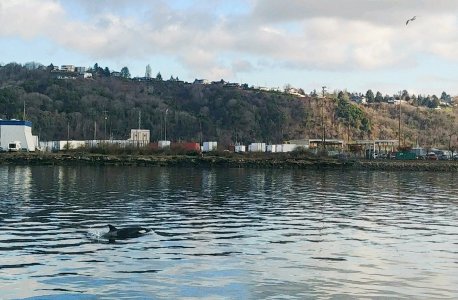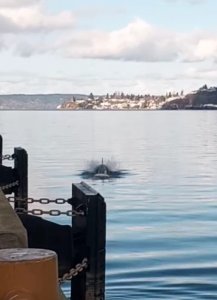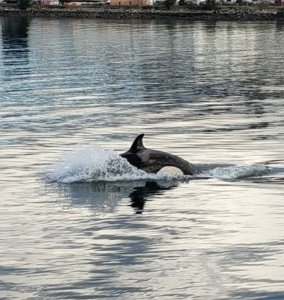Feb. 9 was the first sighting of any kind of orca to be reported in the Blair Waterway.
Parents, you know this moment. You turn your back for one minute and the next thing you know, your calf wanders off in search of a tasty marine mammal morsel...

This little transient orca tyke took a wrong turn and started to enter the Blair Waterway. The whale calf did not travel very far into the Blair (only as far as the first container crane in the waterway), before it promptly changed its mind, headed back out into Commencement Bay and reunited with its mom and the rest of its pod.
No doubt mama whale had a few stern words for her plucky little cherub. However, this adventure-seeking cetacean stole the hearts of all who were lucky enough to see it. Just in time for Valentine’s Day!
Some of our maintenance crew, who were working on a container crane that day, initially thought what they saw was a seal playing around. But then they spotted a dorsal fin, a blowhole, and that unmistakable black and white pattern. They quickly realized they were being treated to this very rare sight (a treat better than chocolate)!
They were able to snap a few photos of the wayward whale youngster before it made its way back out into the bay. (A big thank you to journeyman Craig Brix in our Equipment Maintenance Department for sharing his pictures.)
Upon seeing the photos of this little delinquent, it was love at first sight! Based on other sightings throughout the day, we believe the calf who went on the mini-adventure belongs to the pod known as the T124A2s.

Environmental Connection
Two types of whales in the Salish Sea
The pod seen on Feb. 9 in Commencement Bay are transient orcas (also called Bigg’s killer whales). These are mammal-eating orcas and sometimes spotted in this area in search of food (seals, sea lions, etc.). These whales are distinctly different than the other orca ecotype found in the Salish Sea, the Southern Resident Killer Whales.
Southern Resident Killer Whales are the fish-eating orcas. The two different types of orcas rarely interact with each other and have very different life history patterns (how they travel, hunt, mate, the size of their pods, etc.). Transient orcas travel in matriarchal pods of three to four whales.
Transient orcas are not listed under the Endangered Species Act, like the Southern Resident Killer Whales are, but they are still protected under the Marine Mammal Protection Act.

The Port’s waterways and habitat restoration work
The Port of Tacoma has made significant investments into cleaning up the waterways and Port-owned properties from legacy contamination and restore the nearshore marine environment to provide essential habitat for species that require this special ecosystem. While our goal is salmon recovery, seals and sea lions also benefit, resulting in a very healthy population of both kinds of pinnipeds, which, in turn, makes Commencement Bay attractive to transient orcas in search of a meal.
The Port of Tacoma has also partnered with the Port of Seattle and The Northwest Seaport Alliance (NWSA), along with other agencies, tribes, and organizations, to develop a program to reduce impacts to orcas from large commercial vessels. The Quiet Sound Program is a collaborative initiative that will improve the reporting of whale sightings and the ability to get that information to the pilots of large vessels in the Salish Sea, so they can take action to slow down or move away, from the orcas.
Another measure to note is that cargo ships calling on the Port of Tacoma practice what is called “slow steaming,” which means that they deliberately reduce the vessel’s cruising speed when entering the waterway to get to berth, which helps to prevent accidents with marine mammals — be it seals, sea lions, or naughty but lovable little killer whales.
